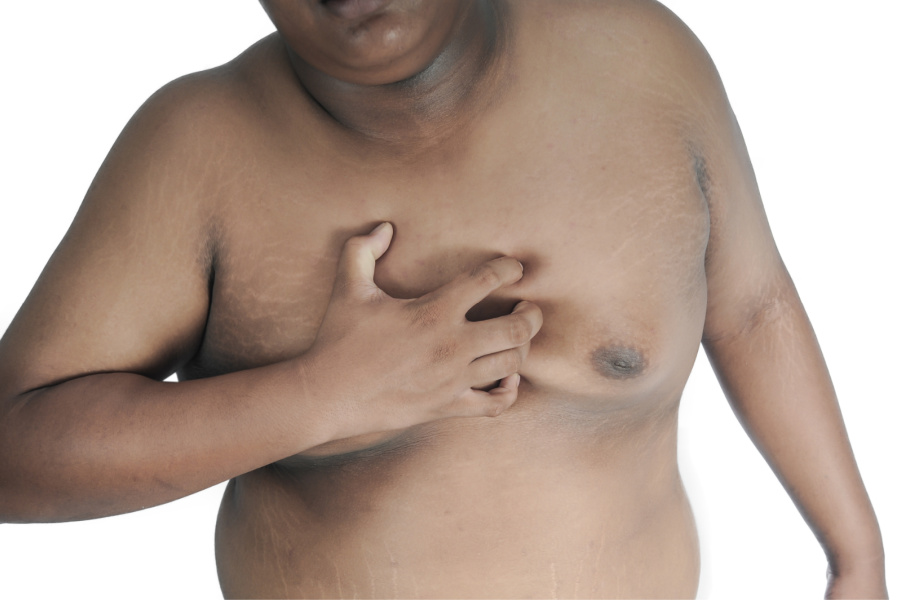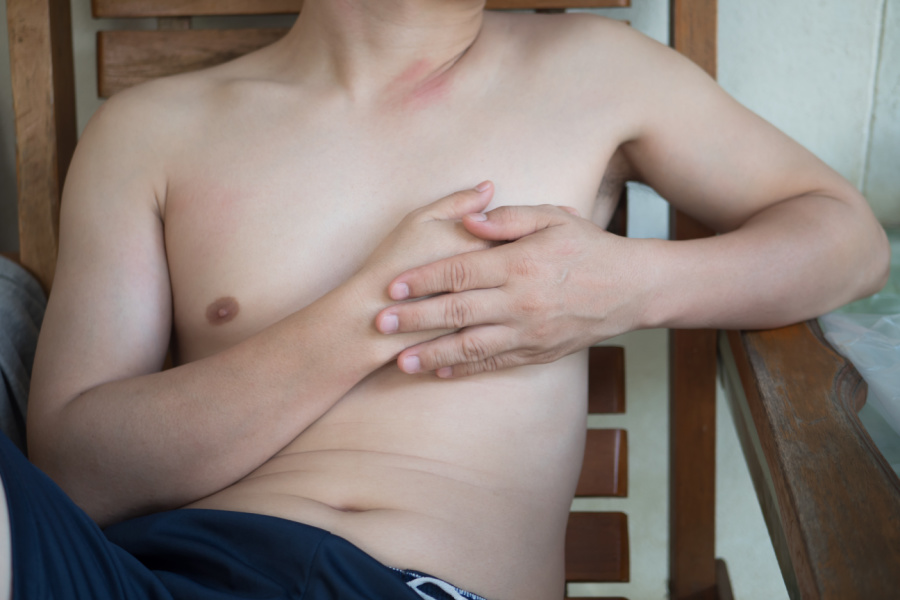
Often referred to as “man boobs,” gynecomastia is a medical condition where males develop excess glandular breast tissue beneath or around the nipples. It’s a fairly common condition, yet many men either don’t recognise the signs or aren’t aware that it can be effectively treated.
In this article, we’ll explore the gynecomastia pinch test — a quick, straightforward method that you or your doctor can use to help identify whether you’re dealing with true gynecomastia or simply excess fatty tissue.

One of the most common questions men have is whether their chest enlargement is true gynecomastia (“gyno”) or simply excess fat.
When the chest contains only fatty tissue without a firm, rubbery glandular lump beneath the nipples — which is a hallmark of gynecomastia — this is typically called pseudogynecomastia or fatty gynecomastia.
Pseudogynecomastia is caused by extra adipose (fat) tissue in the chest. It can occur due to normal hormonal changes (for example, in newborns or adolescent boys during puberty) or as a result of overall higher body weight and increased BMI.
To determine whether you have glandular gynecomastia or fatty gynecomastia, the gynecomastia pinch test is a helpful tool, which we’ll explain shortly. But first, let’s take a quick look at the factors that can cause excess breast tissue in men.
Gynecomastia is typically linked to hormonal imbalances, especially lower-than-normal testosterone levels relative to estrogen.
This imbalance can occur naturally in newborns or during male puberty. It may also arise from medical conditions affecting the thyroid, liver, or kidneys. Additionally, certain medications — including those for anxiety, depression, infertility, or high blood pressure — can contribute to the development of gynecomastia.
Lifestyle factors and substance use can also play a role. Anabolic steroids, opioids, marijuana, and alcohol have all been associated with an increased risk of excess breast tissue in men.
The most reliable way to check for gynecomastia is to perform the gynecomastia pinch test, but you can start with a simple visual assessment by looking at your chest in a mirror without a shirt.
Gynecomastia causes the male breasts to enlarge, which may occur evenly or unevenly. If you notice that your chest appears larger or puffier than usual, it could be a sign of gynecomastia.
For teenage boys or young men going through puberty, some breast enlargement is often normal and usually linked to hormonal changes. In many cases, any excess tissue will naturally decrease over time, and no treatment is necessary.
That said, some young men choose to adopt healthier eating habits and exercise regularly. While this primarily reduces fatty tissue rather than glandular tissue, it can help improve the overall appearance of the chest and support general health.
The gynecomastia pinch test is a simple at-home method that can help determine whether a man has gynecomastia. The test involves gently palpating the tissue around and beneath the nipple to feel for firm, glandular tissue, which is characteristic of true gynecomastia.
When performing the gynecomastia pinch test, the breast tissue may feel tender or slightly uncomfortable, although not everyone experiences this. While you’ll likely notice some soft, fatty tissue, true gynecomastia is characterized by a firmer lump, typically located directly beneath the nipple.
This lump can appear on one or both breasts and often feels like a small, firm disc with tissue radiating outward in concentric circles beneath the nipple. Each lump is usually about the size of a button and may have a slight degree of mobility when pressed.
Does Gynecomastia Cause Tenderness?
Gynecomastia can sometimes be painful or tender. Many men notice soreness or discomfort around the nipples, particularly when the area is pressed or touched.

The gynecomastia pinch test is a simple way to assess whether excess breast tissue may be glandular. While this test can be done at home, only a qualified medical professional can confirm a diagnosis. Here’s how to perform it safely:
Even if you detect a lump or other changes, it’s important to follow up with a healthcare professional to rule out underlying causes such as hormonal imbalances, medication side effects, or other health conditions.
If you suspect you have gynecomastia or pseudogynecomastia, there are several treatment options available.
Dr. Braham, a GMC Registered surgeon at Minor Surgery Clinic, is experienced in performing these procedures to help patients reduce gynecomastia and achieve a more contoured, comfortable chest. Schedule a consultation to explore the best treatment approach for your needs.